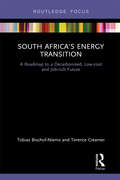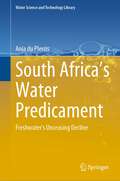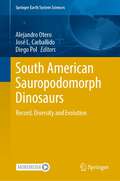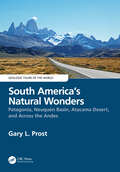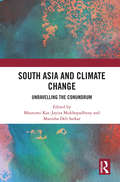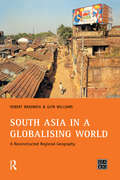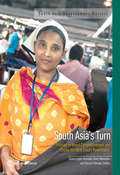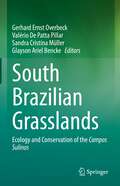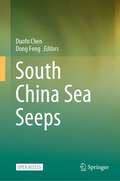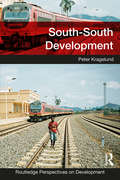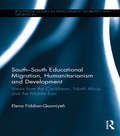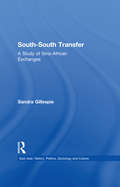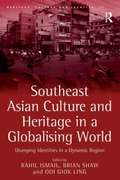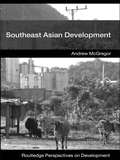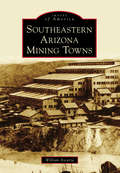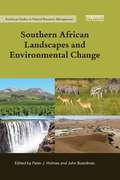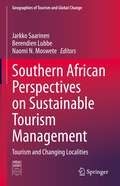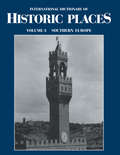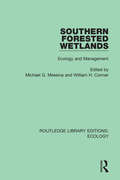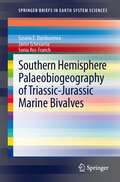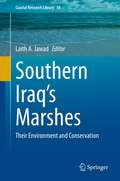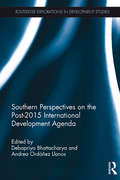- Table View
- List View
South Africa’s Energy Transition: A Roadmap to a Decarbonised, Low-cost and Job-rich Future (Routledge Focus on Environment and Sustainability)
by Tobias Bischof-Niemz Terence CreamerSouth Africa’s energy transition has become a highly topical, emotive and politically contentious topic. Taking a systems perspective, this book offers an evidence-based roadmap for such a transition and debunks many of the myths raised about the risks of a renewable-energy-led electricity mix. Owing to its formidable solar and wind resources, South Africa has an almost unparalleled opportunity to turn solar photovoltaic and onshore wind generators into the country’s power generation workhorses – a role hitherto played by coal. This book shows that a renewables-led mix will not only provide the lowest cost, but will also create more jobs than any of the alternatives currently under consideration. In addition, it offers a glimpse of how South Africa’s low-cost and decarbonised electricity system can power a competitive industrial economy, an electric-mobility revolution and, in the long run, create new export opportunities. This book will be of great interest to energy industry practitioners, as well as students and scholars of energy policy and politics, environmental economics and sustainable development.
South Africa’s Water Predicament: Freshwater’s Unceasing Decline (Water Science and Technology Library #101)
by Anja du PlessisThe book provides a critical evaluation of South Africa’s freshwater resources to illustrate the way in which its freshwater resources, water access, services and infrastructure have continued to decline over the past three decades. The continued decline of water governance, management, water service delivery, dilapidated water infrastructure, dysfunctional local governments and overall excessive water degradation is illustrated and emphasized using real-life examples and case studies from various contexts within the country.The main argument of the book is that South Africa’s freshwater resources have declined to such an extent that it can be described as a predicament. Questionable water governance decisions and reactive water management practices have led to no improvement and/or increased degradation of freshwater resources. An overall lack of service delivery exists across the country, in various contexts, leading to further water and social decline.An inter-disciplinary evaluation of South Africa’s current water predicament is provided, major water crises are prioritized, and suitable recommendations are given to transform its predicament into problems which can be addressed. Suitable background information is given to emphasize the necessity of good water governance, management, and service delivery. South Africa’s freshwater resources are evaluated with specific focus on the decline of informed water governance, management, service delivery and water quality. Factors requiring urgent attention are determined and suitable recommendations and/or actions are provided.An evaluation and overall synthesis focused on the transformation of the predicament into problems is provided. Primary water problems are prioritized according to urgency and suitable recommendations are given to assist in transforming the country’s current complex water predicament into “simpler” water problems. Political will, collaboration with researchers, stakeholders, non-governmental organizations, and cooperation of civil society is required.South Africa’s already scarce freshwater resources and decaying infrastructure will persist and possibly collapse if no major actions or interventions are implemented.
South American Sauropodomorph Dinosaurs: Record, Diversity and Evolution (Springer Earth System Sciences)
by Alejandro Otero José L. Carballido Diego PolSauropodomorpha Huene 1932 is one of the most successful groups of dinosaurs, including the most abundant and diverse herbivorous forms with a worldwide record, extending from the late Triassic to the late Cretaceous. Sauropodomorphs comprise a diverse assemblage of early forms (traditionally called “prosauropods”) and the well-established clade Sauropoda Marsh 1878. Early sauropodomorphs were small to medium sized forms, with long necks and reduced skulls, mostly bipeds and omnivores and were abundant in continental environments in the Late Triassic and Early Jurassic. With more than 150 valid species and a worldwide distribution, Sauropoda includes the dominant herbivorous dinosaurs, from the Middle Jurassic to the Late Cretaceous. Its unique body plan, characterized by gigantic size, graviportal locomotion, long necks and tails, and reduced skulls, made this group an undisputed icon in popular culture since the 19th century. In South America, the sauropodomorph record is particularly rich and abundant, and many species have shed light to understand important milestones in the evolutionary history of this group of dinosaurs. The origin of Sauropodomorpha, the transition to Sauropoda, and the diversification of its most successful evolutionary lineages are largely exemplified by the South American fossil record. In this contribution, we synthetize the diversity of sauropodomorphs from South America, including data on their geographic and stratigraphic provenance, phylogenetics, paleobiology, taphonomy and behaviour, underscoring their significance within the context of sauropodomorph evolution.
South America’s Natural Wonders: Patagonia, Neuquén Basin, Atacama Desert, and Across the Andes (Geologic Tours of the World)
by Gary L. ProstThis book guides readers through the most iconic, geologically significant scenery in South America, points out features of interest, and describes how these features came to be. Starting in the glacial landscapes of southern Patagonia, this field trip guidebook examines the foothills of the Andes of western Argentina to understand its foreland deformation. Across the Andes, one observes deformation, volcanism, and mineral deposits associated with an onshore volcanic arc and uplift in the Atacama Desert of Chile. A transect across the Andes from Mendoza to Valparaiso follows in the footsteps of Darwin and, as an added bonus, explores the premier wine country around Mendoza, Argentina, and the Colchagua Valley, Chile. Features: • Clearly explains the geology of regions with an emphasis on landscape formation. • Lavishly illustrated with numerous colorful maps, diagrams, and photos of breathtaking landscapes and their geological features. • Describes the major geologic features of South America through the device of a geologic tour, making it an accessible read for those without any geologic training, as well as for professionals. • Written in easy-to-understand language, the author brings his own experience to readers who want to explore and understand geologic sites first-hand. South America’s Natural Wonders is an inviting text that gives individuals with no background in geology the opportunity to understand key geologic aspects of local landscapes. It also serves as a guide to undergraduate and graduate-level students taking courses in earth science programs, such as geology, geophysics, geochemistry, mining engineering, and petroleum engineering. Teachers of these courses can also use this book to better understand their local geologic environment and geography.
South Asia and Climate Change: Unravelling the Conundrum
by Mausumi Kar; Jayita Mukhopadhyay; Manisha Deb SarkarThis book provides a comprehensive and interdisciplinary examination of the diverse aspects of climate change in South Asia. The region, home to almost 4% of the world’s population, is under serious threat from climatic disasters. The volume underscores the urgency of addressing cataclysmic events related to climate change and their ramifications on the economy, agriculture and livelihoods of the region. The book discusses the reasons causing climate change as well as highlights normative and ethical considerations involved in the battle against climate change. With case studies from India, Sri Lanka and Bangladesh, it explores issues such as extreme climatic events; energy use, fossil fuels, non-renewable resources and carbon dioxide emission in South Asia; internal migration and climate refugees; the ethical dilemma of sustainable development; technological advancements for extreme weather forecast; and responses to climate change in South Asia. Highlighting the need for striking a balance between developmental imperatives and environmental sustainability, the chapters also show the North-South divide in the research agenda and policies on climate change and the global politics that underlie climate policies. The volume juxtaposes a scientific analysis of factors responsible for climate change with an analysis of the human cost of climate change from the perspective of social sciences. It discusses the challenges faced by developing countries while also offering recommendations and solutions. This book will be of interest to scholars and researchers of climate studies, geography, public policy and governance, sustainable development, development studies, environmental studies, political studies, international relations, political economy, economics and sociology. It will also be useful to practitioners, thinktanks, policymakers and civil society organisations working on environmental management.
South Asia in a Globalising World: A Reconstructed Regional Geography (Developing Areas Research Group)
by Bob Bradnock Glynn WilliamsA comprehensive introduction to the important economic, social and political processes and development issues in this extremely popular region. South Asia provides one of the world's most challenging development contexts and The authors take a different approach to most traditional development texts, making the latest research teacher friendly and presenting material in an accessible manner for non-specialists.
South Asia's Hotspots: The Impact of Temperature and Precipitation Changes on Living Standards (South Asia Development Matters)
by Muthukumara Mani Sushenjit Bandyopadhyay Shun Chonabayashi MarkandyaSouth Asia is particularly vulnerable to climate change. Most previous studies have focused on the projected impacts of sea-level rise or extreme weather - droughts, floods, heatwaves and storm surges. This study adds to that knowledge by identifying the impacts of long-term changes in the climate †“ rising temperatures and changes in precipitation patterns †“ on living standards. It does so by first building an understanding of the relationship between current climate conditions and living standards across South Asia. The study also identifies the set of climate models that are best suited for projecting long-term changes in climate across South Asia. This novel understanding of living standards and climate change is then combined to project impacts of long-term changes in climate on living standards in South Asia. The study finds that higher temperatures will reduce living standards for most of South Asia, with the severity impacts depending on future global greenhouse gas emissions. The study projects “hotspots†?, which are locations where long-term changes in climate will have negative impacts on living standards. Many hotspots are in locations that hitherto have not been identified as particularly vulnerable to climate change. Moreover, hotspots have distinguishing features that vary from country to country. This detailed assessment provides a mosaic of information that enriches our understanding of how climate change will impact people and which populations are most vulnerable. The report also provides guidance on the kinds of actions are most likely to reduce impacts of climate change in each country. The study is a major contribution to our understanding of how increasing temperatures and changing precipitation patterns interact with social and economic structures at a fine granular level across South Asia.
South Asia's Turn: Policies to Boost Competitiveness and Create the Next Export Powerhouse
by Vincent Palmade Gladys Lopez-Acevedo Denis MedvedevSouth Asia has a huge need to create more and better jobs for a growing population †“ especially in the manufacturing industries where it is underperforming as compared to East Asia. The report examines three critical and relatively understudied drivers of competitiveness: -Economies of agglomeration: firms and workers accrue benefits from locating close together in cities or clusters through urbanization and localization. -Participation in global value chains: stronger competitive pressures weed out least productive firms while others improve by gaining access to new knowledge and better inputs. -Firm capabilities: in order to operate close to what would be considered optimum efficiency levels given the prevailing factor prices and thus employ South Asia’s abundant labor. The report shows that South Asia has great untapped competitiveness potential. Realizing this potential would require the governments in the region to pursue second generation trade policy reforms for firms to better contribute to and benefit from global value chains (e.g. facilitating imports for exporters), to facilitate the development of industrial clusters in secondary cities (cheaper and less congested than the metros) as well as to deploy policies to improve the capabilities of firms.
South Brazilian Grasslands: Ecology and Conservation of the Campos Sulinos
by Gerhard Ernst Overbeck Valério De Patta Pillar Sandra Cristina Müller Glayson Ariel BenckeThis volume explores the South Brazilian grasslands, a unique complex of ecosystems in Brazil. Despite high biodiversity and many important ecosystem services, their biodiversity and conservation are neglected, both nationally, and globally. This book provides a state-of-the-art synthesis of knowledge on the biodiversity and its drivers in South Brazilian grasslands and associated ecosystems. Further, the book discusses conservation challenges and options, as well as management strategies that help to maintain the region’s uniqueness. The chapters present information on biodiversity and ecological features of the region, and put this information into the context of historical and current human land uses, allowing for links to global discussions of conservation and sustainable development. Altogether, the book contains 20 chapters organized in four sections. The book is directed at researchers, students and professionals working with biodiversity and sustainable development in southern Brazil, as well as to the international scientific and conservation community interested in grasslands and associated ecosystems, particularly in tropical and subtropical regions.
South China Sea Seeps
by Dong Feng Duofu ChenThis open access book presents an overview on seep systems in South China Sea. It includes numerous illustrations and photographs of the seeps that never seen before. It also introduces multidisciplinary research results to stimulate further research interest.
South-South Development (Routledge Perspectives on Development)
by Peter KragelundSouth-South Development examines the historical background for the current situation: why it suddenly took off again approximately a decade ago; the various vectors of engagement and how they are interrelated; the actors involved; how the revitalisation of South-South development has affected development cooperation ‘as it was’; and finally, how it affects the rest of the Global South. Based on primary research on how Southern actors – via investments, aid, and trade – are changing the face of development both in the Global North and the Global South, this book contextualises the current debates, provides a systematic overview, and brings together the key themes in South-South development. It explains how countries like China, India, and Brazil are influencing domestic politics in other countries of the Global South, how they invest, and how their aid alters power structures between ‘new’ and ‘old’ donors locally. It also explains migration patterns, how they use soft power tools, and how the global governance system is changing as a result of this. This comprehensive and student-focused book includes well developed pedagogy such as text boxes, chapter summaries, key questions, bibliography, weblinks, and annotated further reading. This book offers a unique combination of in-depth insights and secondary data on South-South development, presenting a ‘state-of-the-art’ account of South-South development aimed at students as well as practitioners in disciplines as diverse as International Development Studies, International Relations, Geography, Anthropology, Global Studies, and International Political Economy.
South-South Educational Migration, Humanitarianism and Development: Views from the Caribbean, North Africa and the Middle East (Routledge Studies in Development, Mobilities and Migration)
by Elena Fiddian-QasmiyehThis ground-breaking book is one of the first to analyse the important phenomenon of South-South educational migration for refugees. It focuses particularly on South-South scholarship programmes in Cuba and Libya, which have granted free education to children, adolescents and young adults from two of the world’s most protracted refugee situations: Sahrawis and Palestinians. Through in-depth multi-sited fieldwork conducted with and about Sahrawi and Palestinian refugee students in Cuba and Libya, and following their return to the desert-based Sahrawi refugee camps in Algeria and the urban Palestinian refugee camps in Lebanon, this highly pertinent study brings refugees’ views and voices to the forefront and sheds a unique light on their understandings of self-sufficiency, humanitarianism and hospitality. It critically assesses the impact of diverse policies designed to maximise self-sufficiency and to reduce both brain drain and ongoing dependency upon Northern aid providers, exploring the extent to which South-South scholarship systems have challenged the power imbalances that typically characterise North to South development models. Finally, this very timely study discusses the impact of the Arab Spring on Libya’s support mechanisms for Sahrawi and Palestinian refugees, and considers the changing nature of Cuba’s educational model in light of major ongoing political, ideological and economic shifts in the island state, asking whether there is a future for such alternative programmes and initiatives. This book will be a valuable resource for students, researchers and practitioners in the areas of migration studies, refugee studies, comparative education, development and humanitarian studies, international relations, and regional studies (Latin America, Middle East, and North Africa).
South-South Transfer: A Study of Sino-African Exchanges (East Asia)
by Sandra GillespieThis study directs attention towards a South-South dimension of knowledge transfer: specifically, China's educational exchange programs for Africa.
Southeast Asia: The Human Landscape of Modernization and Development
by Jonathan RiggThe growth economies of Southeast Asia are presented by the World Bank and others as exemplars of development - 'miracle' economies to be emulated. How did the region attain such status? Are the 'other' countries of Southeast Asia able to achieve such a rapid growth? This book charts the development of Southeast Asia, examining the economies of Vietnam, Laos, Cambodia and Burma alongside the established Asian market economies. Drawing on case studies from across the region, the author assesses poverty and ways in which the poor are identified and viewed. Process and change in the rural and urban 'worlds' are examined in detail, focusing on the strengthening rural-urban interaction as 'farmers' make a living in the urban-industrial sector and factories relocate into agricultural areas. Giving prominence to indigenous notions of development, based on Buddhism, Islam and the so-called 'Asian Way', the author critically assesses the conceptual foundations of development, ideas of post-developmentalism, and the 'miracle' thesis. In the light of the experience of one of the most vibrant regions in the world, the book places emphasis on the process of modernization within wider debates of development and challenges the notion that development has been a mirage for many and a tragedy for some.
Southeast Asian Culture and Heritage in a Globalising World: Diverging Identities in a Dynamic Region (Heritage, Culture and Identity)
by Rahil IsmailSoutheast Asia has in recent years become a crossroads of cultures with high levels of ethnic pluralism, not only between countries, sub-regions and urban areas, but also at the local levels of community and neighbourhood. Illustrated by a series of international case studies, this book demonstrates how the forces of 'post-colonialism' in their various manifestations are accelerating social change and creating new and 'imagined' communities, some of which are potentially disruptive and which may well threaten the longer term sustainability of the region. Interdisciplinary in approach, this book brings together geographers, historians, anthropologists, architects, education specialists, planners and sociologists to make connections and new insights and to provide a truly comprehensive view of heritage, culture and identity in this dynamic region.
Southeast Asian Development (Routledge Perspectives on Development)
by Andrew McGregorSoutheast Asia has long fascinated development practitioners and researchers for being one of the few regions of the world that has resisted global trends to become a successful developing region. Divided into accessible thematic chapters, this book adopts a unique perspective of equitable development to outline the strengths and weaknesses of the transformations taking place in the Southeast Asian region. Focusing on four key themes: equality and inequality; political freedom and opportunity; empowerment and participation; and environmental sustainability, these concepts are used to explore Southeast Asian development and trace the impacts that the growing popularity of market-led and grassroots approaches are having upon economic, political and social processes. Whilst the diversity of the region is emphasized so are some of the homogenizing trends such as the concentration of wealth and services in urban areas and the subsequent migration of rural people into urban factories and squatter settlements. The ongoing commercialization and industrialization of rural agriculture as well as the expansion of non-farm income earning opportunities in rural spaces, and the alarming rates of environmental degradation which threaten health and livelihoods are also exposed. In highlighting how Southeast Asian development is unevenly distributing wealth, opportunities and risks throughout the region, this book emphasizes the need for creative new approaches to ensure that benefits of development are equitably enjoyed by all. Including illustrations, case studies and further reading, this book provides an accessible up-to-date introductory text for students and researchers interested in Southeast Asian development, development studies, Asian studies and geography.
Southeastern Arizona Mining Towns
by William AscarzaSoutheastern Arizona has one of the most diverse mining localities in the state. Towns such as Bisbee, Clifton, Globe, Miami, Ray, Silverbell, and Superior have earned reputations as premier metal producers that are most notably known for their copper. Other mining towns that have made their marks in the region include Dos Cabezas, Gleeson, Harshaw District, Helvetia, Patagonia District, Pearce, Ruby, and Tombstone. Mining in southeastern Arizona has significantly influenced the development of mines in northern Sonora, Mexico. The foundation of Mexico's largest copper mine in Cananea was financed by American capital, specifically under the direction of miners and investors from southeastern Arizona. Overall, the process of mining has established the economy of southeastern Arizona, making it a viable source of copper-related minerals in the 21st century's global market.
Southern African Landscapes and Environmental Change (Earthscan Studies in Natural Resource Management)
by John Boardman Peter J. HolmesThis volume provides a textbook and reference work on the physical and biotic landscapes of Southern Africa. It examines the links between these environments and the ways in which they have been, are and will likely be subject to change. It covers the geomorphology, soils, vegetation and land use across a range of landscapes, including mountains, coasts, savannah, drylands and wetlands, and identifies the impacts of current and potential climate change and other factors on these environments. The geographical focus is on the region defined by Namibia, South Africa, Botswana, Mozambique, Zimbabwe, Lesotho and Swaziland. Illustrated throughout in full colour, the book will serve as a reference volume for researchers and environmental professionals internationally, as well as a textbook for senior undergraduate and graduate-level students of geography, ecology and environmental studies in Southern Africa.
Southern African Perspectives on Sustainable Tourism Management: Tourism and Changing Localities (Geographies of Tourism and Global Change)
by Jarkko Saarinen Berendien Lubbe Naomi N. MosweteThis edited collection focuses on tourism development, sustainability and local change in southern Africa. The book offers a range of both conceptual and applied perspectives that address various changes in southern African tourism and community development relations. The key drivers of change that include climate change and globalization form the context for the diverse and interesting set of case studies from the region. The main conceptual grounds of the book cover sustainability, sustainable development goals (SDGs), responsibility, vulnerability, adaptation, resilience, governance, local development and inclusive growth. In this book sustainability is seen as one of the most important issues currently facing the tourism sector, affecting all types and scales of tourism operations and environments in the region. Tourism is an increasingly important economy in the southern African region and the industry is creating changes for communities and environment while also facing major challenges caused by global trends and changes. The book offers a case study driven approach to sustainability needs of tourism development in local community contexts. The case study chapters are linked through the book’s focus on sustainable tourism and local community development. Through emphasizing the need to understand both global change and local contexts in sustainable tourism development, this book is a valuable resource for all those working in the field.
Southern California Surf Music, 1960-1966
by John BlairDick Dale & the Del-Tones began holding weekend dances at the Rendezvous Ballroom in Balboa, California, in the summer of 1960. Over the next year and a half, Dale developed the sound and style that came to be known as "surf music." The result was the development of more powerful guitar amplifiers, a dramatic increase in the sales of Fender guitars and amplifiers, and a shift from New York to West Coast recording studios. More and more people were drawn to the sport of surfing, which became an important part of teen beach culture at the time. Even landlocked teenagers were captured by the moment, carrying surfboards atop their woodies in Phoenix or bleaching their hair blonde in St. Paul. For hundreds of thousands of kids, though, the attraction was not the connection to surfing; it was the connection to the music pioneered by Dick Dale.
Southern Europe: International Dictionary of Historic Places
by Trudy Ring Sharon La Boda Robert M. SalkinFirst Published in 1996. Routledge is an imprint of Taylor & Francis, an informa company.
Southern Forested Wetlands: Ecology and Management (Routledge Library Editions: Ecology #9)
by Michael G. Messina William H. ConnerOriginally published in 1998, Southern Forested Wetlands is an up to date, one source compendium of current knowledge on the wetland ecology of America’s southern forests. This book presents both the ecological and management aspects of these important ecosystems. The book was compiled by members of the Consortium for Research on southern forested wetlands, and was a collaboration of those working to conserve, study, and manage these economically and environmentally influential areas. The book covers geographic ranges from West Virginia to Florida, to Texas and inland north to Arkansas and Tennessee. It also addresses specific wetland types, including deep-water swamps, major and minor alluvial flood plains, pocosins and Carolina bays, mountain fens, pond cypress swamps, flatwoods wetlands, and mangroves.
Southern Hemisphere Palaeobiogeography of Triassic-Jurassic Marine Bivalves
by Javier Echevarría Susana E. Damborenea Sonia Ros-FranchPalaeobiogeography is a complex subject which processes information provided by both Biology and Earth Sciences. It is conceptually and philosophically equivalent to neobiogeography. Nevertheless, its methods are somewhat different, since it is limited by the incompleteness of the fossil record. On the other hand, it has direct access to the time dimension, a key ingredient of organic evolution. Mesozoic benthonic mollusks, and especially bivalves, have a great potential for palaeobiogeographical analysis due to their commonly good preservation, abundance, diversity and high dispersion potential at the larval stage. From a merely descriptive point of view, the analysis of their distribution shows latitudinal gradients and distributional patterns, both at regional and global scales, which are the basis for the recognition of biochoremas or palaeobiogeographical units of different ranks. Moving forward towards a causal palaeobiogeography, these organisms also provide interesting insight into particular biogeographical questions, such as bipolarity and its origin. The evolution in time of the recognized biochoremas can be discussed in relation to palaeoclimas and extinction events. Finally, some of the results obtained from the analysis of the distribution of past bivalve biotas were even used to propose and discuss the development of marine corridors and argue about the distribution of continents in the past.
Southern Iraq's Marshes: Their Environment and Conservation (Coastal Research Library #36)
by Laith A. JawadThe Mesopotamian marshes are important for economic, social, and biodiversity values and have been home to indigenous human communities for millennia. They are regarded as a legendary site. This multi-authored book contains chapters written by world-renowned experts in their field. Both basic and applied information are made available, making the book a must-have for a wide spectrum of users. For example, an understanding of the natural and the social aspects of the marshes, as described here, is an obvious prerequisite for a pest management plan in this area. Scholars interested in wetlands can use this book as a guide to compare different wetlands areas in Asia. The bibliography section contains valuable references to the marsh areas and research in the field. This book serves as an up-to-date comprehensive source of information on different aspects of the southern marshes of Iraq and is aimed at academic scholars, environmentalists, and decision makers.
Southern Perspectives on the Post-2015 International Development Agenda (Routledge Explorations in Development Studies)
by Debapriya Bhattacharya Andrea Ordóñez LlanosAt the turn of the millennium, the unanimous adoption of the Millennium Development Goals (MDGs) by the United Nations General Assembly marked a new chapter in international development. However, voices from the Global South were noticeably absent in shaping the agenda. Fifteen years later, the global context has changed so much that it would have been inconceivable not to have taken voices from the South into account when planning the new Sustainable Development Goals (SDGs). Since its inception in 2012, the Southern Voice on Post-MDG International Development Goals (Southern Voice), a network of 48 think tanks from Africa, Asia and Latin America, has generated a substantial body of original research to feed into various aspects of the post-2015 development agenda, such as the missing dimensions of the MDGs, ways to mitigate existing challenges in delivering on aspired outcomes, and new issues, goals, targets and indicators that are crucial for the next global development framework. Southern Perspectives on the Post-2015 International Development Agenda consolidates this research and stitches together development realities and policy experiences from the Global South, infusing unique local perspectives to the global debate on the post-2015 agenda. The compendium addresses the overarching themes underpinning the new international development framework by focusing on issues such as sustainability and growth, inclusion and social policies, governance and capacities, and financing of the new agenda. Southern Voice seeks to challenge the "knowledge asymmetry" afflicting the global knowledge system by channelling evidence-based policy analyses produced by centres of excellence, located in the Global South. This is a valuable resource for academics and researchers, policymakers and practitioners, and concerned students in search of alternative views on sustainable development.
